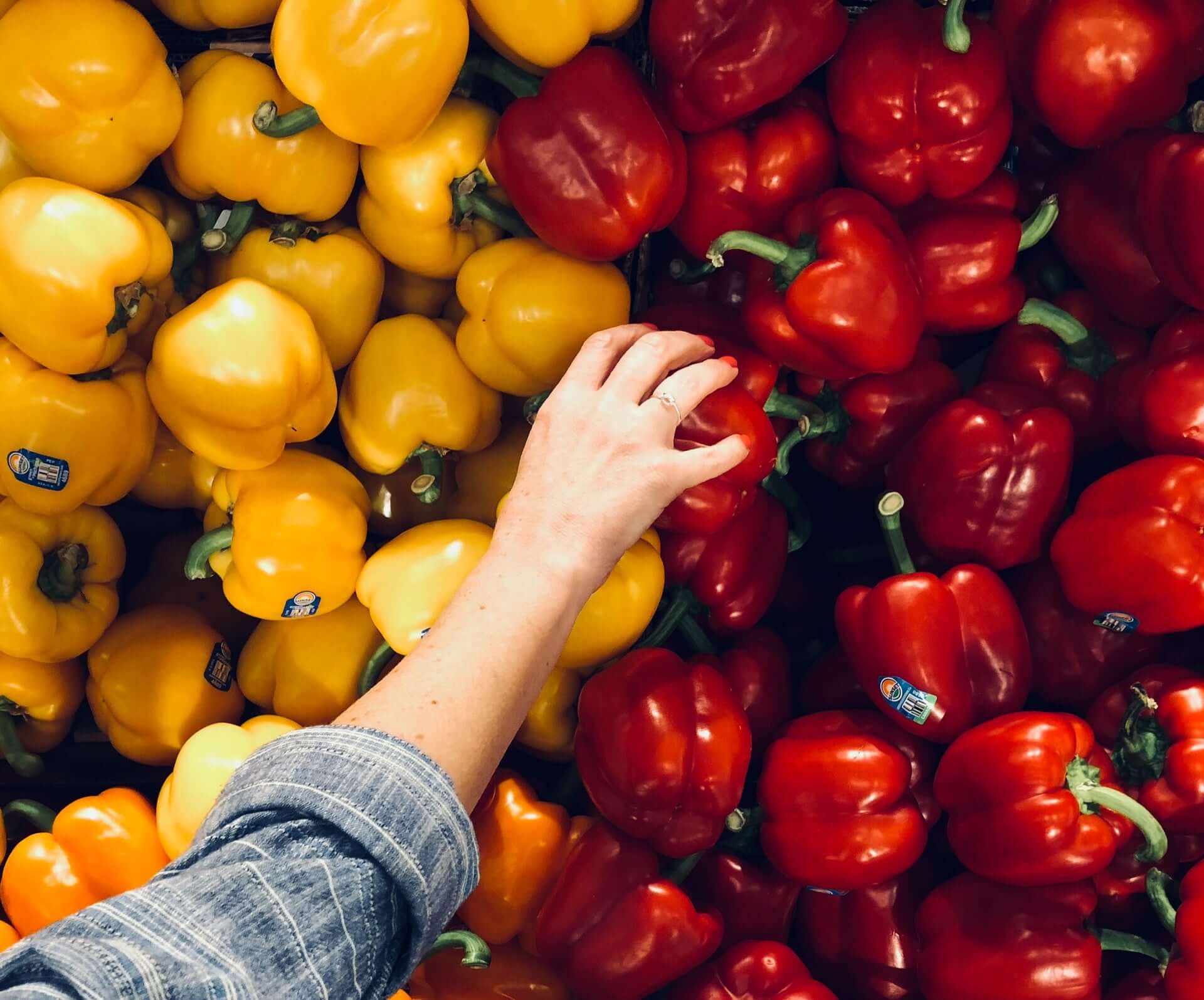
Inhaltsverzeichnis
Shopping food - 7 tips
Going grocery shopping can be quite an ordeal: just another chore that needs to be done. For others, the weekly shop or searching for the best deals is almost a hobby. No matter how you feel about grocery shopping, there are a few tips you can use to make your shopping experience even more sustainable, healthier, and efficient.
7 tips for your grocery shopping
The following suggestions are designed to make your shopping experience more enjoyable overall. Of course, you don't have to implement all of these tips; simply choose what resonates with you and is feasible for you. You can, of course, adapt the recommendations to suit your needs.
If you have any other tips and tricks to make shopping more enjoyable, please share them! 😌
1. Write a shopping list
Let's start with the obvious and banal: the shopping list. Who hasn't been there? At home, you think, "Oh, I only need five items; I'll remember them anyway." Then you suddenly find yourself in the store and have a complete blackout. Only in the parking lot, while putting away the groceries, do you remember what you actually came for—annoying.
By writing a list in advance, you'll be organized and prepared. Your entire shopping experience will be more efficient. You'll also be less likely to make impulse purchases and focus more on what you really need.
We often notice while cooking or eating which foodstuffs are running low or need to be restocked. Therefore, it's a good idea to create a way to jot down these things immediately in the kitchen. For example, you can get a small stack of paper or attach a list and pen to the wall. The latter option is great because it allows other people in the household to quickly jot something down.
There are also some great apps these days that let you create shopping lists and share them with other people. If you often write your shopping lists but then forget them at home, this is definitely a good option for you. After all, you're less likely to leave your phone at home. 😋
2. Reduce food waste
The biggest help in reducing food waste is checking what you have at home before you go shopping. This can sometimes be difficult to do, for example, if you're doing a quick grocery run on your way home from work.
Nevertheless, our goal should be to buy only what we can actually consume. Unfortunately, far too much food is still thrown away in German households. And that harms our environment.
Fruit and vegetables spoil faster and therefore often end up in the trash. Strategic shopping can prevent this: If you know you probably won't eat that avocado until the weekend, feel free to pick up an unripe one. The same goes for bananas, pears, and anything else that can ripen well at home.
Sometimes it's simply a matter of having a little fruit and vegetables at home because you're not sure exactly when you'll want to eat them. In these cases, it's worth choosing varieties that naturally keep longer or are easy to store.These include potatoes, tomatoes, carrots and apples.
If we happen to buy fruit or vegetables that we probably won't be able to use in time, soups, smoothies, or sauces are a great way to prepare and enjoy larger quantities of these foods in a timely manner. Also, keep in mind that these soups and sauces can be frozen! This way, no food has to be thrown away – even if you don't have a use for it right now.
You can also find further information and tips on reducing food waste in this blog post.
3. Take advantage of the supermarket’s architecture
Scanning every aisle in the supermarket can take forever. And even if you already know your way around and where to find things, you're usually still looking left and right.
Anyone who wants to make their shopping more efficient, healthier, and often cheaper can still use the layout of supermarkets to their advantage.
In most grocery stores, the produce section and refrigerated shelves are usually located in the outer areas. Therefore, it makes sense to stop there first. Fresh produce like fruits and vegetables, dairy alternatives, and other plant-based products end up in your shopping cart first.
The middle aisles mostly contain processed foods, canned goods, confectionery, and packaged goods. Of course, there are exceptions, z.B. Canned vegetables.
Personally, I always find it incredibly satisfying to be able to put a lot of unpackaged, fresh, and healthy items on the conveyor belt at the end. It makes me feel good about my shopping. For this reason, I've gotten into the habit of first focusing on the outer shelves and areas of the supermarket, then moving "inside" if necessary.

Photo by Rob Maxwell on Unsplash
4. Look for offers and discounted goods
Admittedly, I'm not one of those people who checks every supermarket's specials before shopping. I'm not forward-thinking enough for that (not to mention that I wouldn't have the relevant promotional flyers...).
What I do like to pay attention to, however, are signs advertising special offers in the supermarket itself. I especially like corners in the produce department where “overripe” produce is offered at a discount.
Far too many "unattractive" or seemingly overripe vegetables and fruits are still thrown away. However, some supermarkets now offer these at a reduced price. Be sure to keep an eye out for them on your next shopping trip! Refrigerated produce that no longer has a long shelf life is also often sold at a discount. Of course, you should only buy these types of produce if you can use them immediately.
Ripe fruit is especially sweet. For this reason, some recipes even explicitly call for very ripe fruit, such as z.B. the bananas you need for banana bread.
5.Help yourself to frozen foods and canned goods
You may have grown up believing that fresh food is essential and that frozen or bottled alternatives aren't nearly as nutritious as their fresh counterparts.
And I wouldn't deny that fresh food is important. However, these days, frozen foods (fruits and vegetables) in particular are just as nutritious as fresh ones. This is because foods that are subsequently frozen are usually harvested at their peak ripeness. This preserves nutrients and flavor.
This applies primarily to packaged frozen goods in their “natural” form, i.e. foods without the addition of flavor enhancers, sugar, spice mixtures, etc.
For some people or households, it's easier to store some food in the freezer or pantry. Others prefer to have mostly fresh produce at home. No matter which type you are—it's perfectly fine!
Frozen or bottled foods also have the advantage of keeping significantly longer and being easy to portion. This is simply practical! Especially when you want to prepare a wholesome meal but don't have much fresh produce on hand.
Canned goods are also particularly good for a quick meal. They also keep very well and are easy to prepare. Many people on a plant-based diet enjoy protein- and iron-rich canned foods like chickpeas, lentils, or beans. If you want, you can make sure that as little salt as possible has been added when buying canned goods.
6. Shop seasonally and regionally
Seasonal produce has many advantages. Firstly, it's often cheaper, meaning we get more for less. Secondly, seasonal produce is fresher and tastier, precisely because it can be harvested at full ripeness.
When we focus on the seasonality of fresh foods, we also tend to eat more varied foods. This allows us to discover new varieties, dishes, and flavors in a fun way!
Seasonal and regional shopping not only benefits us as consumers, but also the environment. Locally sourced and in-season products have much shorter delivery routes, which can reduce the amount of harmful environmental gases emitted.
Weekly markets are highly recommended here. The food sold there is almost always locally sourced. Not only is buying goods at the market significantly cheaper than at the supermarket (especially if you need larger quantities), but you also get to support smaller, local businesses, which is a great thing.
7. Reduce your own plastic consumption
It is time to Ending a relationship with plastic. Step by step. For the environment. I've already talked about this in more detail in another article, how you can reduce your plastic consumption. Therefore, here is a brief summary:
Fortunately, using reusable shopping bags is becoming more and more commonplace. Bags made of recycled material or fabric are also usually larger and last significantly longer than simple paper or plastic bags.At the same time, you save a little money every time you bring your own bags.
There are now also reusable alternatives for the small, transparent plastic bags for vegetables and fruit. The same goes for the bags at the bakery, by the way! I've yet to meet a bakery employee who wasn't happy to pack my baked goods in the bread bag I brought with me. 😊
If you would like to learn more about healthy eating, mindfulness, sustainability or family and pregnancy, Check out more exciting blog articles on these topics here.

Photo by The Creative Exchange on Unsplash



























Leave a comment
This site is protected by hCaptcha and the hCaptcha Privacy Policy and Terms of Service apply.